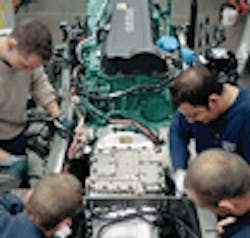Study: EPA ’07 engines far exceeded emission expectations
A new study, released by a group of government and industry organizations including the Dept. of Energy, the Environmental Protection Agency, the California Air Resources Board and the Engine Manufacturers Assn., indicates that “clean diesel technologies” used in engines manufactured beginning in 2007 not only reduced certain emissions by 90% over 2004 engines, but “exceeded substantially even those levels required by law.
The ACES (Advanced Collaborative Emissions Study) Phase 1 study, conducted by the Coordinating Research Council and the Health Effects Institute, found that “current engine models” produced 98% less carbon monoxide, 10% less nitrogen oxide, 95% less non-methane hydrocarbons and 89% less particulate matter than mandated by the EPA 2007 diesel engine emissions rules.
“Diesel engines are the workhorses of the nation’s transportation infrastructure because they are fuel efficient, durable and reliable,” said Jed Mandel, president of the Engine Manufacturers Assn. “We can now add near-zero emissions to the list of diesel’s positive attributes.
“These latest emissions figures are a testament to the trucking and engine manufacturing industries’ deep commitment to the environment,” said ATA president & CEO Gov. Bill Graves. “We’re proud of the significant progress that has been made and we look forward to building upon this foundation as we continue to work toward a more sustainable future.”
The study’s authors reported that detailed chemical characterization of exhaust species emitted from four 2007 model-year “heavy heavy-duty diesel engines (HHDDE)” manufactured by Caterpillar, Cummins, Detroit Diesel and Volvo were examined, between March 2007 and August 2008.
The objectives of the ACES Phase 1 study were to:
- Quantify the reduction in both regulated and unregulated emissions from advanced diesel engines
- Provide regulated and unregulated emissions data for this new engine technology
- Make data available to support the selection of one engine for the ACES Phase 3 health study,
- Provide initial guidance for the ACES Phase 3 health study using the regulated and unregulated emissions information from ACES Phase 1.
As indicated above, Phase 1 is regarded as just the initial stage of ACES, a five-year, comprehensive program that will test the emissions and health effects of new-technology diesel engines both to document the improvements that have been made and to ensure that there are no unintended emissions from these new technologies.
According to ATA, along with reducing emissions through clean diesel technologies, trucking’s “progressive environmental sustainability program” will reduce fuel consumption by 86 billion gallons and CO2 emissions by 900 million tons for all vehicles over the next 10 years by:
- Setting governors on post-1992 trucks to limit speeds to no more than 65 mph
- Enacting a national speed limit of 65 mph for all vehicles
- Reducing engine idling
- Reducing congestion by improving highways
- Using “more productive” truck combinations
- Supporting national fuel economy standards for trucks
- Increasing fuel efficiency by encouraging participation in the EPA SmartWay Transport Partnership program.
A PDF file of the entire 158-pg. ACES Phase 1 study may be accessed here.
